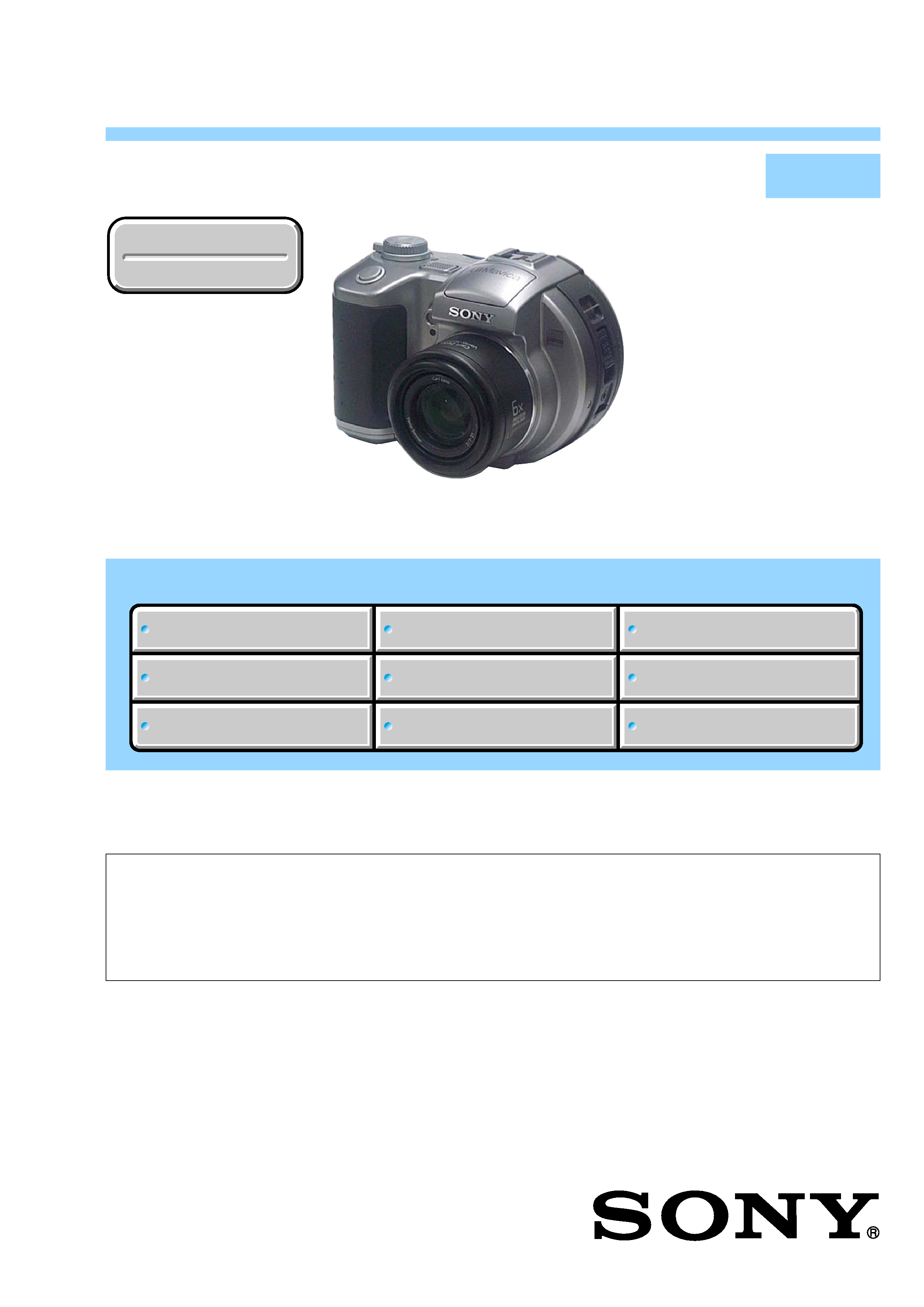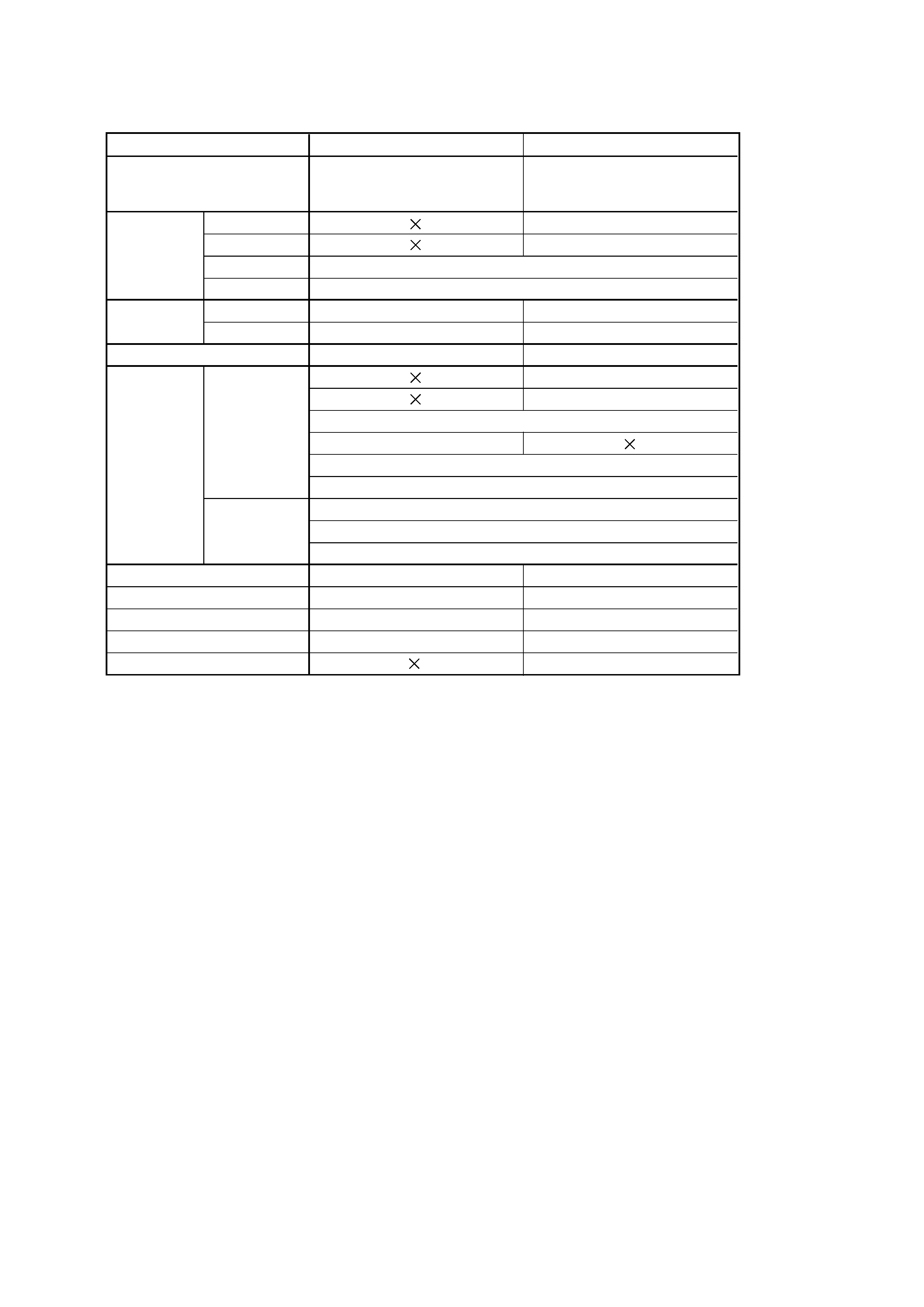
SERVICE MANUAL
DIGITAL STILL CAMERA
LEVEL
2
Link
SERVICE NOTE
DISASSEMBLY
BLOCK DIAGRAMS
FRAME SCHEMATIC DIAGRAMS
SCHEMATIC DIAGRAMS
PRINTED WIRING BOARDS
ADJUSTMENTS
REPAIR PARTS LIST
SPECIFICATIONS
SERVICE NOTE
DISASSEMBLY
BLOCK DIAGRAMS
FRAME SCHEMATIC DIAGRAMS
SCHEMATIC DIAGRAMS
PRINTED WIRING BOARDS
ADJUSTMENTS
REPAIR PARTS LIST
SPECIFICATIONS
Link
Revision History
Revision History
Ver 1.0 2002. 04
On the SY-76 board
This service manual procides the information that is premised
the circuit board replacement service and not intended repair
inside the SY-76 board.
Therefore, schematic diagram, printed wiring board and
electrical parts list of the SY-76 board are not shown.
The following pages are not shown.
SY-76 board
Schematic diagram ......................... Pages 4-15 to 4-40
Printed wiring board ........................ Pages 4-57 to 4-60
Electrical parts list ........................... Pages 6-15 to 6-23
The above-described information is shown in service
manual Level 3.
MVC-CD250/CD400
US Model
Canadian Model
E Model
Chinese Model
Australian Model
Japanese Model
MVC-CD250/CD400
AEP Model
UK Model
Korea Model
Tourist Model
MVC-CD400
·For INSTRUCTION MANUAL, refer to SERVICE MANUAL, LEVEL 1 (992996841.pdf).
· This service manual contains information for Japanese model as well.
·Table for differences of function of each model
Photo: MVC-CD400

-- 2 --
MVC-CD250/CD400
SPECIFICATIONS
COVER
COVER
System
Image device
MVC-CD400
8.98 mm (1/1.8 type) color CCD
Primary color filter
MVC-CD250
6.64 mm (1/2.7 type) color CCD
Primary color filter
Total pixels number of camera
MVC-CD400
Approx. 4 130 000 pixels
MVC-CD250
Approx. 2 110 000 pixels
Lens
MVC-CD400
3
× zoom lens
f = 7.0 21.0 mm (9/32 27/32 inches)
(34 102 mm (1 3/8 4 1/8 inches)
when converted to a 35 mm still camera)
F2.0 2.5
MVC-CD250
3
× zoom lens
f = 6.4 19.2 mm (9/32 25/32 inches)
(41 123 mm (1 5/8 4 7/8 inches)
when converted to a 35 mm still camera)
F3.8 3.9
Camera
Effective pixels number of camera
MVC-CD400
Approx. 3 950 000 pixels
MVC-CD250
Approx. 1 980 000 pixels
Exposure control
MVC-CD400
Automatic exposure, Shutter speed
priority, Aperture priority,Manual
exposure, Scene selection (4 modes)
MVC-CD250
Automatic exposure, Scene selection
(3 modes)
White balance
Automatic, Daylight, Cloudy,
Fluorescent, Incandescent, One-push*
* MVC-CD400 only
Data formats
Moving images: MPEG1
Still images: JPEG, GIF (for Clip
Motion), TIFF
Audio with still image: MPEG1
(Monaural)
Recording media
8 cm CD-R/CD-RW
Flash
MVC-CD400
Recommended distance (ISO set to
Auto): 0.5 m to 5.0 m (19 3/4 inches to
196 7/8 inches)
MVC-CD250
Recommended distance (ISO set to
Auto): 0.8 m to 3.5 m (31 1/2 inches to
137 7/8 inches)
AC-L10A/L10B AC power adaptor
Power requirements
100 to 240 V AC, 50/60 Hz
Rated output voltage
DC 8.4 V, 1.5 A in operating mode
Operating temperature
0
°C to +40°C (32°F to +104°F)
Storage temperature
20
°C to +60°C (4°F to +140°F)
Dimensions
125
× 39 × 62 mm
(5
× 1 9/16 × 2 1/2 inches) (w/h/d,
excluding maximum protrusions)
Mass
Approx. 280 g (10 oz)
NP-FM50 battery pack
Used battery
Lithium-ion battery
Maximum voltage
DC 8.4 V
Nominal voltage
DC 7.2 V
Capacity 8.5 Wh (1 180 mAh)
Operating temperature
0
°C to +40°C (32°F to +104°F)
Dimensions
38.2
× 20.5 × 55.6 mm
(1 9/16
× 13/16 × 2 1/4 inches) (w/h/d)
Mass
Approx. 76 g (3 oz)
Accessories
·AC-L10A/L10B AC power adaptor (1)
·Power cord (mains lead) (1)
·USB cable (1)
·NP-FM50 battery pack (1)
·A/V connecting cable (1)
·8 cm CD adaptor (1)
·Mavica disc (7) (CD-R (6), CD-RW (1))
·Shoulder strap (1)
·Lens cap (1)
·Lens cap strap (1)
· CD-ROM (SPVD-009) (1)
·Operating instructions (1)
Design and specifications are subject to change
without notice.
Drive
Readout Non-contact optical readout (using
semiconductor laser)
Laser
Wavelength: 779 to 789 nm
Maximum output: 23 mW
Input and Output connectors
A/V OUT (MONO) (Monaural)
Minijack
Video: 1 Vp-p, 75
, unbalanced,
sync negative
Audio: 327 mV (at a 47 k
load)
Output impedance 2.2 k
ACC jack Mini-minijack (ø 2.5 mm)
USB jack mini-B
LCD screen
Used LCD panel
6.2 cm (2.5 type) TFT drive
Total number of dots
123 200 (560
× 220) dots
General
Used battery pack
NP-FM50 (supplied)
Power requirements
7.2 V
Power consumption (during shooting
with LCD backlight on)
MVC-CD400
3.0 W
MVC-CD250
2.5 W
Operating temperature
0
°C to +40°C (32°F to +104°F)
Storage temperature
20
°C to +60°C (4°F to +140°F)
Dimensions
MVC-CD400
Approx. 138
× 95 × 103 mm
(5 1/2
× 3 3/4 × 4 1/8 inches)
(W/H/D, excluding maximum
protrusions)
MVC-CD250
Approx. 138
× 95 × 101 mm
(5 1/2
× 3 3/4 × 4 inches)
(W/H/D, excluding maximum
protrusions)
Mass
MVC-CD400
Approx. 638 g (1 lb 7 oz) (including
battery pack NP-FM50, disc, and lens
cap)
MVC-CD250
Approx. 608 g (1 lb 6 oz) (including
battery pack NP-FM50, disc, and lens
cap)

-- 3 --
MVC-CD250/CD400
Table for differences of function
Model
MVC-CD250
MVC-CD400
US, Canadian, E, Japanese,
US, Canadian, AEP, UK, E,
Destination
Australian, Chinese
Japanese, Australian, Chinese,
Korea, Tourist
Carl Zeiss lens
a
Lens
Movable lens
a
Optical zoom
3
×
Digital zoom
6
×
CCD imager
Size
1/2.7 type
1/1.8 type
Pixels
2.1 mega
4.1 mega
AF optical system
AF illuminator (LED)
Hologram AF (Laser diode)
2272
× 1704
2272 (3:2)
Still
1600
× 1200
1600 (3:2)
Image size
1280
× 960
640
× 480
320 (HQ)
Movie
320
× 240
160
× 112
CD board
CD-394
CD-393
FS board
FS-85
FS-84
JK board
JK-225
JK-224
PK board
PK-66
PK-65
LS board
LS-61

-- 4 --
MVC-CD250/CD400
1.
Check the area of your repair for unsoldered or poorly-soldered
connections. Check the entire board surface for solder splashes
and bridges.
2.
Check the interboard wiring to ensure that no wires are
"pinched" or contact high-wattage resistors.
3.
Look for unauthorized replacement parts, particularly
transistors, that were installed during a previous repair. Point
them out to the customer and recommend their replacement.
4.
Look for parts which, through functioning, show obvious signs
of deterioration. Point them out to the customer and
recommend their replacement.
5.
Check the B+ voltage to see it is at the values specified.
6.
Flexible Circuit Board Repairing
·Keep the temperature of the soldering iron around 270°C
during repairing.
· Do not touch the soldering iron on the same conductor of the
circuit board (within 3 times).
· Be careful not to apply force on the conductor when soldering
or unsoldering.
Unleaded solder
Boards requiring use of unleaded solder are printed with the lead-
free mark (LF) indicating the solder contains no lead.
(Caution: Some printed circuit boards may not come printed with
the lead free mark due to their particular size.)
: LEAD FREE MARK
Unleaded solder has the following characteristics.
· Unleaded solder melts at a temperature about 40
°C higher than
ordinary solder.
Ordinary soldering irons can be used but the iron tip has to be
applied to the solder joint for a slightly longer time.
Soldering irons using a temperature regulator should be set to
about 350
°C.
Caution: The printed pattern (copper foil) may peel away if the
heated tip is applied for too long, so be careful!
· Strong viscosity
Unleaded solder is more viscous (sticky, less prone to flow) than
ordinary solder so use caution not to let solder bridges occur such
as on IC pins, etc.
· Usable with ordinary solder
It is best to use only unleaded solder but unleaded solder may
also be added to ordinary solder.
SAFETY CHECK-OUT
After correcting the original service problem, perform the following
safety checks before releasing the set to the customer.
SAFETY-RELATED COMPONENT WARNING!!
COMPONENTS IDENTIFIED BY MARK 0 OR DOTTED LINE WITH
MARK 0 ON THE SCHEMATIC DIAGRAMS AND IN THE PARTS
LIST ARE CRITICAL TO SAFE OPERATION. REPLACE THESE
COMPONENTS WITH SONY PARTS WHOSE PART NUMBERS
APPEAR AS SHOWN IN THIS MANUAL OR IN SUPPLEMENTS
PUBLISHED BY SONY.
ATTENTION AU COMPOSANT AYANT RAPPORT
À LA SÉCURITÉ!
LES COMPOSANTS IDENTIFÉS PAR UNE MARQUE 0 SUR LES
DIAGRAMMES SCHÉMATIQUES ET LA LISTE DES PIÈCES SONT
CRITIQUES POUR LA SÉCURITÉ DE FONCTIONNEMENT. NE
REMPLACER CES COMPOSANTS QUE PAR DES PIÈSES SONY
DONT LES NUMÉROS SONT DONNÉS DANS CE MANUEL OU
DANS LES SUPPÉMENTS PUBLIÉS PAR SONY.
WARNING!!
WHEN SERVICING, DO NOT APPROACH THE LASER
EXIT WITH THE EYE TOO CLOSELY. IN CASE IT IS
NECESSARY TO CONFIRM LASER BEAM EMISSION,
BE SURE TO OBSERVE FROM A DISTANCE OF MORE
THAN
30
cm
FROM THE
SURFACE
OF THE
OBJECTIVE LENS ON THE OPTICAL PICK-UP BLOCK.
CAUTION
Use of controls or adjustments or performance of procedures
other than those specified herein may result in hazardous
radiation exposure.
CAUTION:
The use of optical instrument with this product will increase eye
hazard.

-- 5 --
MVC-CD250/CD400
TABLE OF CONTENTS
1.
SERVICE NOTE
1-1.
Note for Repair ································································ 1-1
1-2.
Discharging of the FLASH unit's Charging Capacitor ··· 1-1
1-2-1. Preparing the Short Jig ···················································· 1-1
1-2-2. Discharging the Capacitor ··············································· 1-1
1-3.
Notes on Handling the Laser Diode
[Laser Unit (D9001: MVC-CD400) and
Base Unit (DDX-G3000)] ·················································· 1-2
1-3-1. Precautions for Checking Emission of Laser Diode
[Base Unit (DDX-G3000)] ·············································· 1-2
1-3-2. Soldering Conditions of Laser Unit
(D9001: MVC-CD400) ··················································· 1-2
1-4.
Description on Self-diagnosis Display ···························· 1-3
1-5.
Power Supplying Method ················································ 1-3
2.
DISASSEMBLY ......................................................... 2-1
2-1.
Side Cabinet Block Assembly ········································· 2-2
2-2.
Cabinet (Rear) Block Assembly ······································ 2-2
2-3.
Lens Block Assembly ······················································ 2-3
2-4.
Stroboscope Block Assembly ·········································· 2-4
2-5.
Flash Unit ········································································ 2-5
2-6.
BT Holder Assembly ······················································· 2-5
2-7.
SY-76 Board ···································································· 2-6
2-8.
DDX-G3000 Complete Assembly ··································· 2-7
2-9.
Base Unit ········································································· 2-7
2-10. PK-65/66 Board ······························································· 2-8
2-11. LCD Module ···································································· 2-9
2-12. Circuit Boards Locaion ················································· 2-10
2-13. Flexible Boards Locaion ··············································· 2-11
3.
BLOCK DIAGRAMS
3-1.
Overall Block Diagram ··················································· 3-1
3-10. Power Block Diagram 1 ················································ 3-19
3-11. Power Block Diagram 2 ················································ 3-21
4.
PRINTED WIRING BOARDS AND
SCHEMATIC DIAGRAMS
4-1.
Frame Schematic Diagrams
Frame Schematic Diagram (1/2) ····································· 4-1
Frame Schematic Diagram (2/2) ····································· 4-3
4-2.
Schematic Diagrams ························································ 4-5
CD-393 (1/2) (CCD IMAGER)
(MVC-CD400) ································································ 4-7
CD-393 (2/2) (CAMERA MODULE)
(MVC-CD400) ································································ 4-9
CD-394 (1/2) (CCD IMAGER)
(MVC-CD250) ······························································ 4-11
CD-394 (2/2) (CAMERA MODULE)
(MVC-CD250) ······························································ 4-13
PK-65/66 (1/2)
(LCD DRIVE, TIMING GENERATOR) ····················· 4-41
PK-65/66 (2/2) (BACK LIGHT DRIVE) ····················· 4-43
FS-84/85 (DC IN, CONTROL SWITCH) ···················· 4-45
JK-224/225 (JACK) ······················································ 4-47
LS-61 (LENS CAP SWITCH) (MVC-CD400) ············ 4-49
CONTROL SWITCH BLOCK (ZK-860/880) ············· 4-50
4-3.
Printed Wiring Boards ··················································· 4-51
CD-393 (MVC-CD400) ················································ 4-53
CD-394 (MVC-CD250) ················································ 4-55
PK-65/66 ······································································· 4-61
FS-84/85 ········································································ 4-65
JK-224/225 ···································································· 4-67
LS-61 (MVC-CD400) ··················································· 4-69
FP-482/489/490 ····························································· 4-71
4-4.
Waveforms ····································································· 4-73
Section
Title
Page
Section
Title
Page
4-5.
Mounted Parts Location ················································ 4-78
5.
ADJUSTMENTS
1-1.
Adjusting Items when Replacing
Main Parts and Boards ···················································· 5-2
5-1.
Camera Section Adjustments ··········································· 5-3
1-1.
Preparations Before Adjustment
1-1-1. List of Service Tools ························································ 5-3
1-1-2. Preparations ····································································· 5-4
1-1-3. Discharging of the Flashlight Power Supply ··················· 5-4
1-1-4. Precaution
1.
Setting the Switch ···························································· 5-6
2.
Order of Adjustments ······················································ 5-6
3.
Subjects ··········································································· 5-6
4.
Preparing the Flash Adjustment Box ······························· 5-7
1-2.
Initialization of A, B, D, E, F, 7, 9 Page Data
1-2-1. Initialization of A, D Page Data
1.
Initializing A, D Page Data ·············································· 5-8
2.
Modification of A, D Page Data ······································ 5-8
3.
A Page Table ···································································· 5-8
4.
D Page Table ···································································· 5-8
1-2-2. Initialization of B, E, F, 7, 9 Page Data
1.
Initializing B, E, F, 7, 9 Page Data ·································· 5-9
2.
Modification of B, E, F, 7, 9 Page Data ··························· 5-9
3.
B Page Table ···································································· 5-9
4.
E Page Table ···································································· 5-9
5.
F Page Table ·································································· 5-10
6.
7 Page Table ··································································· 5-12
7.
9 Page Table ··································································· 5-12
1-3.
Video System Adjustment
1.
Video Output Level Adjustment ···································· 5-13
1-4.
Camera System Adjustments ········································· 5-14
Data Setting During Camera System Adjustments ········ 5-14
Picture Frame Setting ···················································· 5-15
Check on the Oscilloscope ············································ 5-15
1.
Hall Adjustment (MVC-CD250 only) ··························· 5-16
2.
Flange Back Adjustment
(Using the minipattern box) ·········································· 5-17
3.
Flange Back Adjustment
(Using the flange back adjustment chart
and subject more than 500 m away) ······························ 5-18
4.
Flange Back Check ························································ 5-19
5.
F No. Compensation ······················································ 5-19
6.
Mechanical Shutter Adjustment ···································· 5-20
7.
Light Value Adjustment ················································· 5-20
8.
Mixed Color Cancel Adjustment ··································· 5-21
9.
Auto White Balance 3200K Standard Data Input 1 ······ 5-21
10.
Auto White Balance 3200K Standard Data Input 2 ······ 5-22
11.
Auto White Balance 3200K Standard Data Input 3 ······ 5-22
12.
Auto White Balance 3200K Check 1 ···························· 5-23
13.
Auto White Balance 3200K Check 2 ···························· 5-24
14.
Auto White Balance 3200K Check 3 ···························· 5-24
15.
Auto White Balance 5800K Standard Data Input 1 ······ 5-25
16.
Auto White Balance 5800K Standard Data Input 2 ······ 5-26
17.
Auto White Balance 5800K Standard Data Input 3 ······ 5-26
18.
Auto White Balance 5800K Check 1 ···························· 5-27
19.
Auto White Balance 5800K Check 2 ···························· 5-28
20.
Auto White Balance 5800K Check 3 ···························· 5-29
21.
Color Reproduction Adjustment ···································· 5-30
22.
CCD White Defect Compensation ································ 5-31
23.
CCD Black Defect Compensation ································· 5-32
24.
CCD Linearity Check ···················································· 5-33
25.
Strobe White Balance Adjustment ································· 5-34
26.
AF Illumination Check (MVC-CD250 only) ················ 5-36
1-5.
LCD System Adjustments ············································· 5-37
